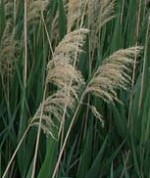 Common reed is a vigorous warm season perennial and a member of the grass family, Poaceae, that also includes corn, rice, and bamboo. It is native to north America and occurs in the wetlands in all states of the US except Alaska. Plants prefer full sun and wet soils, and can be found in ditches, swales, banks of streams and ponds, estuaries, and marshes. Although common reed has been useful in conservation and restoration projects it can become invasive and form dense thickets that crowd out other plants.
Common reed is a vigorous warm season perennial and a member of the grass family, Poaceae, that also includes corn, rice, and bamboo. It is native to north America and occurs in the wetlands in all states of the US except Alaska. Plants prefer full sun and wet soils, and can be found in ditches, swales, banks of streams and ponds, estuaries, and marshes. Although common reed has been useful in conservation and restoration projects it can become invasive and form dense thickets that crowd out other plants.
Description: With thick, long, unbranched rhizomes, common reed grows up to twenty feet tall and has a leafy, hollow, unbranched stem. The broad, flat leaf blades are green to grayish green, deciduous, seven to twenty four inches long, and have rough margins. The purplish flowers are carried in large feathery highly branched panicles six to twenty inches long from mid-summer to fall. Reproduction is primarily by rhizomes although seed and stolons are also significant.
Control: Common reed is difficult to control. Cut or pull the plants in late July and remove all the cut or pulled parts. Applying a mulch of black plastic over cut plants for a growing season is effective in greatly reducing the number of plants. In severe cases two herbicides can be employed: Imazapyr to actively growing green foliage after full leaf elongation from June to the first killing frost; and glyphosate to plants in full bloom from late summer up to the first killing frost. Choose formulations for wetlands. Several applications may be necessary.